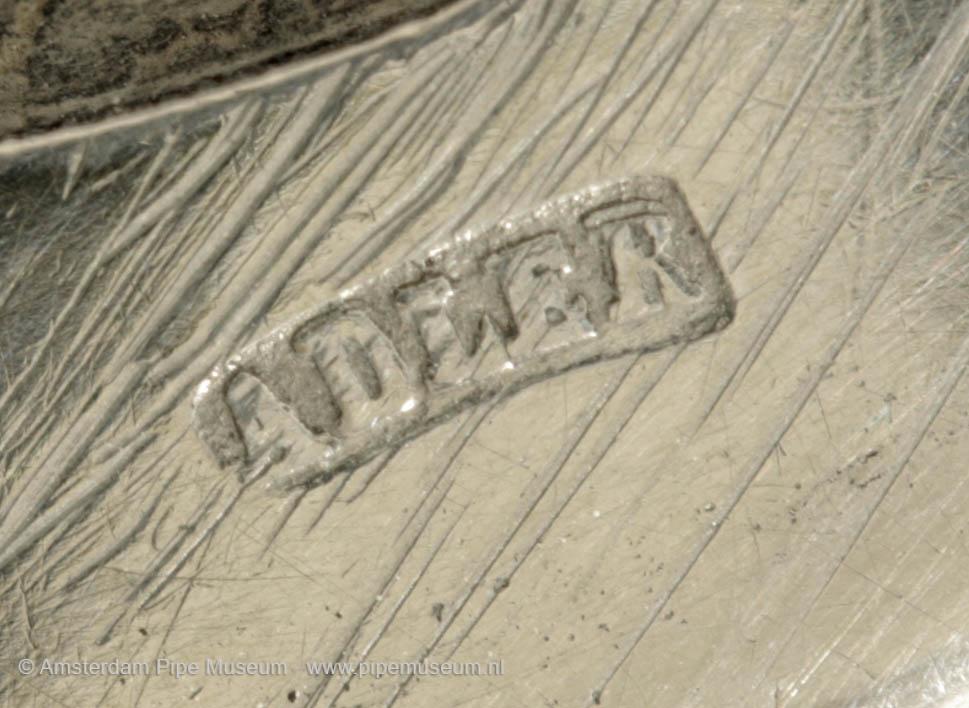Museum number:
| APM 18.500 |
Subcollection:
| meerschaum pipes |
Title:
| tobacco pipe |
Keyword:
| double portrait, Saint George and the dragon |
Description:
| Tabakspijp van meerschuim met cilindrische Hongaar ketel met licht uitstaande filtrand, ronde onderzijde zonder hiel en oplopende steel met schijfvormige manchet. Ketel voorzijde in reliëf onder een grote keizerlijke kroon met schuin kruisje gehouden door vliegende engelen de borstbeelden van keizer Franz Josef I en keizerin Elisabeth Amalie Eugénie verbonden door een tak met lauwerbladeren. Steelhoek in hoogreliëf naar de roker gekeerde Sint Joris op een paard, een kronkelende draak aan zijn voeten, achter de voorstelling een boogvorm opgebouwd uit C-voluten. Steel rondom in reliëf een schakelketting. Montage met zilveren klepdeksel met gevleugelde engelenkopjes, maskerkopjes en bekroning van een kroon, een meervoudige sluitveer met vrucht. Dekselrand ingeslagen twee zilvermerken en "ADLER". Manchet zilveren ring met repeterende bladornamenten en borgoog. Manchet ingeslagen in het meerschuim "ADLER". |
Date:
| Period | 1890 - 1900 |
Dimensions:
| Bowl | Height | 5.79 in (14.7 cm) |
| Width | 2.76 in (7 cm) | |
| Stem | Length | 4.33 in (11 cm) |
Characteristics
| Pipe type | stub stemmed pipe |
| Pipe shape | Hungarian |
| Material | meerschaum (block) (stone) |
| Technique | carved |
| Colour | ivory white |
| Other materials | silver (metal) |
| Finish | gemonteerd |
| Traces of use | gerookt |
Production
| Continent | Europe |
| Region international | Eastern Europe |
| Country | Hungary |
| Town | Budapest |
| Maker #1 | Philipp Adler (meerschaum carver) |
| Continent | Europe |
| Region international | Central Europe |
| Country | Austria |
| Region national | Vienna (province) |
| Town | Vienna |
| Maker #2 | Josef Gedlitzka (silversmith ) |
| Mark | "ADLER" (intaglio, manchet) gehaltemerk portretkop met A4 (ingeslagen, dekselring) JG (zilvermerk) (ingeslagen, dekselring) |
Acquisition
| Year | 2007 |
| Provenance | 's-Graveland, Arjan de Haan |
| Engeland, particulier bezit, internetveiling, december 2006 |
Comments
| Verkooptekst: Large rákcózi pipe bowl, made in commemoration of Emperor Franz Joseph I and Empress Elisabeth Amalie Eugenie. The master pipe maker who carved this pipe was Philip Adler in Budapest and it is marked "ADLER" both on the meerschaum shank, as well as on the silver lid. Furthermore, the silver is hallmarked with the pentagonal hallmark with womans head indicating the silver is fourth grade (750., first used 1866). The "A" on the right side of the head indicates Vienna. The third mark is a small oval hallmark with "JG" which means the silver on this pipe was made by Josef Gedlitzka (in Vienna). This pipe is 15 cm. (6 inches) tall. On the front, the pipe depicts the portraits of the 2 royals, crowned with a crown held by two angels. In between the bowl and the shank is a carving of St. George slaying the dragon. As emperor, Franz Joseph held 3 major titles: Emperor of Austria, Apostolic King of Hungary and King of Bohemia from 1848 until 1916. The crown used on this pipe (the front, as well as the lid) is the Hungarian Holy Crown (Stephanscrown). The above information makes perfectly sense since Emperor Franz Joseph I was crowned King of Hungary in Buda (as in Budapesth) in 1867. It is unclear what the connection with St. George and the Austro Hungarian Empire is. Perhaps it is because he was widely seen as the model for chivalry, or perhaps it had a specific meaning to the recipient in case this pipe was meant as a gift for some official occasion. Walter Loewe, Liten Svensk Historia om Cigarrer och Cigariller, Boras, 1996, p 6. Afbeelding van dezelfde ruiter te paard op een meerschuim sigarenhouder. |
Literature
| Don Duco, Fabels en feiten over de meerschuim pijp. Amsterdam, 2009. afb 127. Dit exemplaar (signatuur). |
If you have any comments, suggestions or additions, click here to send us an email













